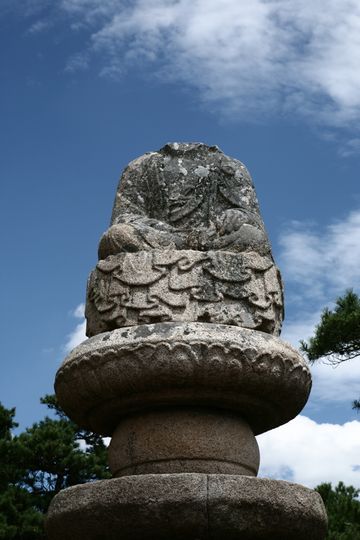경주 남산 용장사곡 석조여래좌상
| 경주 남산 용장사곡 석조여래좌상 Stone Seated Buddha in Yongjangsagok Valley of Namsan Mountain, Gyeongju |
|
 경주 남산 용장사곡 석조여래좌상, 국가문화유산포털, 문화재청. |
|
| 대표명칭 | 경주 남산 용장사곡 석조여래좌상 |
|---|---|
| 영문명칭 | Stone Seated Buddha in Yongjangsagok Valley of Namsan Mountain, Gyeongju |
| 한자 | 慶州 南山 茸長寺谷 石造如來坐像 |
| 주소 | 경북 경주시 내남면 용장리 산1-1번지 |
| 지정(등록) 종목 | 보물 제187호 |
| 지정(등록)일 | 1963년 1월 21일 |
| 분류 | 유물/불교조각/석조/불상 |
| 시대 | 통일신라 |
| 수량/면적 | 1구 |
| 웹사이트 | 경주 남산 용장사곡 석조여래좌상, 국가문화유산포털, 문화재청. |
|
|
|
해설문
국문
이 석불은 조각도 우수하지만 불상의 받침(臺座)이 특이한 석불이다.
자연 암반 위에 원반 모양의 돌을 층층이 쌓아 올린 형태로 우리나라에서는 보기 드문 예이다. 그 위에 앉은 불상은 머리를 잃었지만, 왼쪽 어깨 위에 가사(袈裟), 부처의 옷를 고정하는 끈과 매듭이 새겨져 있다. 옷자락이 무릎 아래로 흘러 대좌를 덮고 있다. 손 모양은 일반적인 손 위치와는 반대로 왼손은 손바닥을 아래로 하여 왼 무릎 위에, 오른손은 손바닥을 위로 향하게 하여 다리 위에 두었다.
1920년 용장사라 새긴 기와가 발견되었다. 『삼국유사』에 “경덕왕(742~765) 재위 시기의 승려 대현(大賢 혹은 太賢)이 용장사에 살았다. 절에는 돌로 만든 미륵장육상(彌勒丈六像), 1장(丈) 6척(尺) 크기의 상, 약 4.8m이 있었다. 대현이 항상 이 장육상을 돌면 장육상도 역시 대현을 따라 얼굴을 돌렸다”는 기록이 있다.
영문
Stone Seated Buddha in Yongjangsagok Valley of Namsan Mountain, Gyeongju
This buddha statue is presumed to have been made around the mid-8th century during the Unified Silla period (668-935). Although its head has been lost, the statue’s advanced artistry can be seen in the remains of the statue and its pedestal. The shape of the statue’s pedestal, which sits atop a natural rock and is made by stacking six rounded stones of alternating small and large diameters, is rarely found in Korea.
Various details attest to the intricate carving technique used to create the statue, such as the strings and knots for fastening the robes on the left shoulder and the realistically defined folds of the garment flowing below the buddha’s knees.
This statue is located in Yongjangsagok Valley. The name of this valley comes from the temple Yongjangsa, which was a large temple during the Unified Silla period. In 1920, roof tiles inscribed with this temple’s name were found near this statue, so it is presumed to have been a part of the temple premises.
Yongjangsa is also mentioned in the Memorabilia of the Three Kingdoms (Samguk yusa), which says that when the monk Daehyeon stayed at this temple during the reign of King Gyeongdeok (r. 742-765), there was a large stone statue of Maitreya, the Future Buddha, measuring around 4.8 m in height. Daehyeon would walk circles around the statue as a part of his spiritual practice, and the statue’s head was said to spin around, following Daehyeon as he walked. It is thought that this stone seated statue is the one mentioned in this story.
영문 해설 내용
이 불상은 통일신라시대인 8세기 중엽에 만들어진 것으로 추정된다. 비록 머리는 사라졌지만 우수한 조각 기법을 보이는 작품이다. 자연 암반 위에 원반 모양의 돌 6개를 층층이 쌓아 대좌로 사용한 형태는 한국 석불에서는 보기 드문 사례이다.
불상의 여러 표현에서 숙련된 조각 기술을 확인할 수 있다. 왼쪽 어깨 위에는 옷을 고정하는 끈과 매듭이 새겨져 있고, 무릎 아래로 흘러내린 옷자락에는 주름이 사실적으로 묘사되어 있다.
이 불상이 있는 곳은 용장사곡으로, 이곳에 신라의 큰 사찰이었던 용장사가 있었기 때문에 붙은 이름이다. 1920년 석불 주변에서 '용장사'라는 글자가 새겨진 기와가 발견되어, 이 석불도 사찰 영역에 포함되었던 것으로 추정된다.
『삼국유사』에 따르면, 경덕왕(재위 742-765) 때 승려 대현이 용장사에 살았으며, 용장사에는 돌로 만든 약 4.8m 높이의 미륵불이 있었다고 한다. 대현이 항상 불상 주위를 돌면 불상도 역시 대현을 따라 얼굴을 돌렸다고 하며, 이 이야기에 언급된 불상이 바로 이 불상인 것으로 여겨진다.